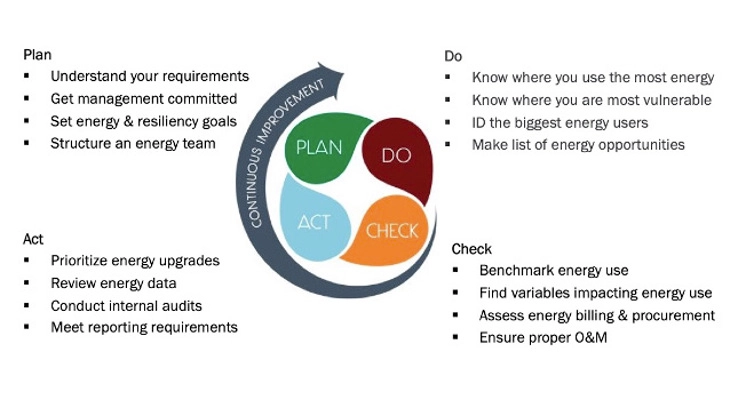About ISO 50001:
ISO stands for International Organization for Standardization. ISO specifications are implemented across various businesses to measure the level of excellence amongst products, services, systems and procedures. It is necessary in this era of globalization to maintain consistency and quality across industries and nations. An ISO implementation qualifies a management system, manufacturing process, service or documentation to have all the requirements of standardization and quality assurance.
ISO certifications exist in different industry areas like energy management, quality management, environmental management, safety and health management etc.
ISO standards ensure consistency. Each certification pertains to different sets of criteria and standards and is classified numerically.
The most commonly implemented ISO certifications are ISO 9001, ISO 14001 and ISO 45001. ISO 9001 (QMS) is for quality management systems, ISO 14001 (EMS) is for environmental management systems whereas ISO 45001 (OH & S) is for occupational health and safety management.
But today we will talk about ISO 50001 – energy management systems or better known as ‘EnMs’ in short. This standard is worlds first and most recognized for ‘energy management system’. The current version is ISO 50001:2018. It helps in providing a guideline to establish an energy management system and is a global standard for energy audit. It can be applicable for buildings, building complexes, utilities, light and medium industries, heavy industries, government facilities, military bases etc. Its implementation improves operational efficiency, helps in saving energy and cutting costs.
An energy management system involves implementing a systematic approach to energy efficiency. It comprises best practices in project management, energy monitoring, energy awareness and helps in integrating an energy policy that monitors an organization’s approach towards energy use and performance.
Implementation process:
- The initial assessment determines implementation gaps and whether the mandatory requirements of the standard are being met and the capability of the management system to proceed to the next stage.
- The second stage determines the effectiveness of the system and seeks to confirm whether the system is implemented and operational.
- The third stage reviews corrective actions if any to be taken to address the observations noted during the first and second stage and concludes recommendation for certification.
- The organization’s files are reviewed by an independent and impartial panel and decision to award the certification is made.
- Successful certification is communicated and awarded to the organization.
ISO 50001 is designed to identify and implement energy projects that save money by integrating with smart technologies that provide data and help control energy use. Continuity is one of the core concerns of the international standard. Therefore, with the introduction of a systematic energy management according to ISO 50001, a so-called Plan-Do-Check-Act (PDCA) principle is implemented. (see diagram)
The energy management standard lasts for three years and is subject to mandatory audits every year to ensure compliance. At the end of the three years, a reassessment audit is required in order to receive the standard for an additional three years.
Benefits:
ISO 50001 is based on the same management system model used for ISO 9001 and 14001. This compatibility makes it easier for organizations to integrate energy management into their quality and environmental management efforts.
The ISO 50001 energy management system combines best practices in project management, energy monitoring, and energy awareness along with an energy policy that governs an organization’s approach towards energy use and performance. This benefits an organization by enabling significant energy savings that are persistent since the organization’s personnel must continually monitor energy use and resolve anomalies or incidents that cause energy waste. Following are a list of benefits enjoyed by implementing EnMs.
- Cost savings through improved energy management.
- More ethically sound and cost-effective procurement procedures.
- Reduced waste and increased efficiency.
- Sustainable energy use in the face of rising costs.
- Reduced operational and overhead costs lead to increased profitability.
- Reduced air emissions, such as greenhouse gases.
- Increased efficiency of energy sources.
- Increased assurance of legal and internal compliance.
- Variables affecting energy use and consumption are identified.
- Increased understanding of energy use and consumption via communication.
- Improved corporate image and credibility among customers, clients and stakeholders.
- Increased energy awareness among staff members at all levels.
An ISO 50001 certification is accepted by most organizations and will gain an enhanced brand value among industry circles at a global level. It will result in an improved reputation and stakeholder trust.






